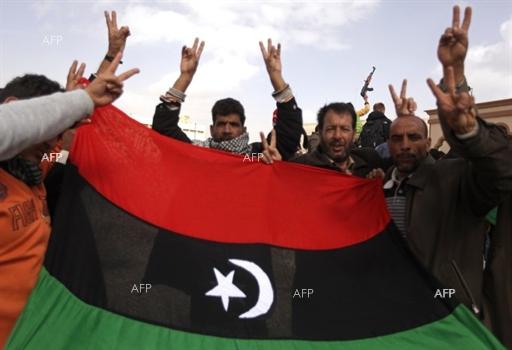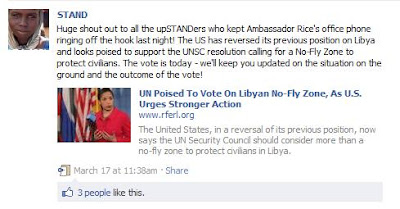 |
| Anti-Qaddafi Libyan rebels wave their national flag |
The face of the world has greatly changed since my last post on STAND's social media presence just a few weeks ago. An international coalition led by the U.S. and NATO forces militarily intervened in Libya to enforce the UN Security Council Resolution of a no-fly zone. A new rebel movement grew momentum in the recently seceded Southern Sudan, further complicating its short and fragile history. Members of U.S. Congress continue to debate the controversial details of the federal budget, increasing the looming possibility of a government shutdown. All of these events, which have dominated the news cycles for weeks, have also impacted the operations of STAND and their social media campaigns.
Because of these developments around the world, it has been extremely interesting to follow STAND's social media presence throughout the past few weeks. The impact of these events have not only proven that STAND utilizes their online tools to promote themselves as an organization, but that they also use social media to empower their members to help accomplish STAND's main agenda. This, my friends, is groundswell in action! For example, when accounts from Libya regarding violent government crackdown on anti-Qaddafi civilians were growing, STAND decided to use its social media presence to help their members advocate government action that would stop these atrocities against innocent civilians. Through their Facebook, Twitter, and blog pages, they were able to take action by providing downloadable talking points for UpSTANDers to "Call the State Department now at (202) 647-5291 and ask for a no-fly zone over Libya."
 |
Not only were STAND's efforts unique in this way, but they were also fruitful. When the UN Security Council Resolution was passed on March 17th implementing a no-fly zone over Libya to reduce attacks against civilians, STAND was ecstatic and wanted to congratulate its fellow activists on their call to action. This further portrayed their use of social media to empower their own groundswell:
Another example of how STAND's presence has been impacted by current events was when their annual Pledge2Protect campaign (which I discussed in my previous post) was disrupted due to the failure of Congress to introduce the genocide prevention bill in time for STAND to advocate during this event. This is in part due to the government standoff regarding the budget and calls to reduce U.S. expenditures on foreign assistance (which, FYI accounts to less than 1% of the entire budget). In spite of this, STAND decided to remain flexible and through its social media sources, shift the focus of their campaign from advocating this genocide prevention bill to providing invaluable training through a genocide prevention and activism boot camp. Through suggestions from their members via online platforms, they were able to announce these changes and even decided to waive the $25 registration fee if those who already registered wanted to attend. Talk about handling a crisis situation well!
Throughout this entire monitoring process, I have come to believe that STAND is unique in not only utilizing social media for marketing extremely well, but also for introducing never-seen-before initiatives that combine traditional and contemporary tactics of activism. Because of this, it has been such a great and exceptional organization to monitor.
However, through this monitoring process I have also come to understand that STAND still faces challenges that they will need to overcome in order to maximize their social media potential. For instance, as it is an extremely large and decentralized organization with over 800 chapters all over the world, it has been difficult for social media auditors (like me) to analyze its large-scale impact. Although STAND does have major social media outlets for its central headquarters, I would suggest further building their database to not only include a list of STAND chapters all over the world, but also links to the individual chapters' social media pages as well. This way fellow UpSTANDers can see what the other chapters have been doing, and STAND officials can also keep a virtual eye on their different branches to make sure that the groundswell does not turn against them.
 |
| An Google map of STAND's different locations |
Furthermore, as I mentioned in my last report, STAND is currently going through an "identity crisis," as they have recently changed their official name and main mission due to an expansion of their efforts. For the sake of being able to monitor their social media impact, I believe it is important for STAND to be able to find an efficient title that is unique and able to track. Although the word "STAND" is indeed clever, it is just not distinct enough to distinguish itself in this information-laden social media world. Even their slogan, "Don't stand by, stand up!" is a phrase that is used in PSAs for anti-bullying campaigns. Thus, although STAND has accomplished so much, I believe that they still need to find cohesion within their organizational identity and overall mission. This issue will probably arise as STAND continues to grow as an organization, as they will confront the need to find an identity that will remain constant throughout their expansion.
In conclusion, I believe that everything STAND stands for (no pun intended) makes it such a unique organization to represent. Its ability to empower the youth to not only be aware of ongoing injustices around the world, but also refuse to stand idly by as they occur, is completely consistent with their strategic use of novel social media tactics. I believe that in their short history, STAND's actions have really impacted the discourse on U.S. foreign policy and a large part of their success has been accomplished with the assistance of social media tools. It will be interesting to keep an eye on this organization and see how much they can grow--and how much they can shape anti-genocide policy--in the coming years.
 |
| What do YOU stand for? |
















